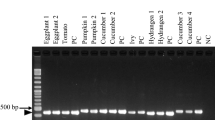Abstract
We present a novel one-step PCR method for the identification of Cerastoderma edule and C. glaucum. Sequence differences found in the internal transcribed spacer region (ITS) of the ribosomal DNA of the two cockles allowed us to design two species-specific reverse primers. These two primers were used in a multiplex reaction, together with a forward universal primer to amplify specific fragments with different lengths in each cockle (190 and 470 bp in C. edule and C. glaucum, respectively). The successful and specific amplifications obtained for two natural populations in each species as well as in canned products lend support to the usefulness of these markers.


Similar content being viewed by others
References
FAO (2000) Fisheries Department, Fishery information, Data and Statistics Unit FISHSTAT Plus: Universal software for fishery statistical time series. Version 2.3
Winnepenninckx B, Backeljau T, De Wachter R (1993) Extraction of high molecular weight DNA from molluscs. Trends Genet 9:407
Freire R, Arias A, Méndez J, Insua A (2010) Sequence variation of the internal transcribed spacer (ITS) region of the ribosomal DNA in Cerastoderma species. J Mollusc Stud 76:77–86
Thompson JD, Gibson TJ, Plewniak F, Jeanmougin F, Higgins DG (1997) The Clustal_X windows interface: flexible strategies for multiple sequence alignment aided by quality analysis tools. Nucleic Acids Res 24:4876–4882
Nicholas KB, Nicholas HBJr, Deerfield DW II (1997) GeneDoc: analysis and visualization of genetic variation. Embnew News 4:14
Rychlik W, Rhoads RE (1989) A computer program for choosing optimal oligonucleotides for filter hybridization, sequencing and in vitro amplification of DNA. Nucleic Acids Res 17:8543–8551
Altschul SF, Madden TL, Schäffer AA, Zhang J, Zhang Z, Miller W, Lipman DJ (1997) Gapped BLAST and PSI-BLAST: a new generation of protein database search programs. Nucleic Acids Res 25:3389–3402
Hillis DM, Dixon MT (1991) Ribosomal DNA: molecular evolution and phylogenetic inference. Q Rev Biol 66:411–453
Connell L (2002) Rapid identification of marine algae (Raphidophyceae) using three-primer PCR amplification of nuclear internal transcribed spacer (ITS) regions from fresh and archived material. Phycologia 41:15–21
Hu Z, Guiry MD, Duan D (2009) Using the ribosomal internal transcribed spacer (ITS) as a complement marker for species identification of red macroalgae. Hydrobiologia 635:279–287
Heath DD, Rawson PD, Hilbish TJ (1995) PCR-based nuclear markers identify alien blue mussel (Mytilus spp.) genotypes on the west coast of Canada. Can J Fish Aquat Sci 52:2621–2627
Heath DD, Hatcher DR, Hilbish TJ (1996) Ecological interaction between sympatric Mytilus species on the west coast of Canada investigated usin PCR markers. Mol Ecol 5:443–447
Toro JE (1998) Molecular identification of four species of mussels from southern Chile by PCR-based nuclear markers: the potential use in studies involving planktonic surveys. J Shellfish Res 17:1203–1205
Santaclara FJ, Espineira M, Cabado G, Aldasoro A, González-Lavin N, Vieites JM (2006) Development of a method for the genetic identification of mussel species belonging to Mytilus, Perna, Aulacomya, and other genera. J Agric Food Chem 54:8461–8470
Fernández A, García T, Asensio L, Rodríguez MA, González I, Hernández PE, Martín R (2001) PCR-RFLP analysis of the internal transcribed spacer (ITS) region for identification of 3 clam species. J Food Sci 66:657–661
López-Piñon MJ, Insua A, Méndez J (2002) Identification of four scallop species using PCR and restriction analysis of the ribosomal DNA internal transcribed spacer region. Mar Biotechnol 4:495–502
Freire R, Fernández-Tajes J, Méndez J (2008) Identification of razor clams Ensis arcuatus and Ensis siliqua by PCR-RFLP analysis of ITS1 region. Fish Sci 74:511–515
White LR, McPheron BA, Stauffer JR Jr (1994) Identification of freshwater mussel glochidia on host fishes using restriction fragment length polymorphisms. Mol Ecol 3:183–185
Dixon DR, Sole-Cava AM, Pascoe PL, Holland PWH (1995) Periostracal adventitious hairs on spat of the mussel Mytilus edulis. J Mar Biol Assoc UK 75:363–372
Fernández-Tajes J, Freire R, Méndez J (2010) A simple one-step PCR method for the identification between European and American razor clams species. Food Chem 118:995–998
Martínez I, Malmheden Yman I (1998) Species identification in meat products by RAPD analysis. Food Res Int 31:459–466
Freire R, Insua A, Méndez J (2005) Cerastoderma glaucum 5S ribosomal DNA: characterization of the repeat unit, divergence with respect to Cerastoderma edule, and PCR-RFLPs for the identification of both cockles. Genome 48:427–442
Brock V (1978) Morphological and biochemical criteria for the separation of Cardium glaucum (Bruguière) and C. edule (L.). Ophelia 17:207–214
Machado MM, Costa AM (1994) Enzymatic and morphological criteria for distinguishing between Cardium edule and C. glaucum of the Portuguese coast. Mar Biol 120:535–544
Hummel H, Wolowicz M, Bogaards RH (1994) Genetic variability and relationships for poñulation of Cerastoderma edule and of the C. glaucum complex. Netherlands J Sea Res 33:81–89
Bossier P (1999) Authentication of seafood products by DNA patterns. J Food Sci 64:189–193
Brock V, Christiansen G (1989) Evolution of Cardium (Cerastoderma) edule, C. lamarcki and C. glaucum: studies of DNA-variation. Mar Biol 102:505–511
André C, Lindegarth M, Jonsson PR, Sundberg P (1999) Species identification of bivalve larvae using random amplified polymorphic DNA (RAPD): differentiation between Cerastoderma edule and C.lamarcki. J Mar Biol Assoc UK 79:563–565
Acknowledgments
We thank Dr. Philippe Borsa, Dr. Maciej Wolowicz and Ms. Isabel Pan Souto for supplying samples and Jose García Gil for the technical assistance in the laboratory. This work was funded by the Ministerio de Ciencia y Tecnología and Ministerio de Educación y Ciencia of Spain and Xunta de Galicia through projects IFD97-1295, RZ2006-00005-00-00 and XUGA 10300B97, respectively.
Author information
Authors and Affiliations
Corresponding author
Rights and permissions
About this article
Cite this article
Freire, R., Arias, A., Méndez, J. et al. Identification of European commercial cockles (Cerastoderma edule and C. glaucum) by species-specific PCR amplification of the ribosomal DNA ITS region. Eur Food Res Technol 232, 83–86 (2011). https://doi.org/10.1007/s00217-010-1369-5
Received:
Revised:
Accepted:
Published:
Issue Date:
DOI: https://doi.org/10.1007/s00217-010-1369-5




